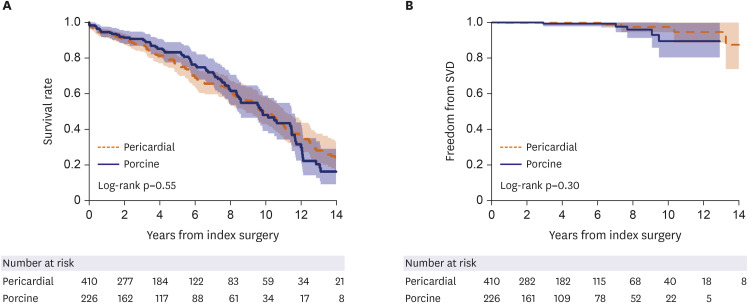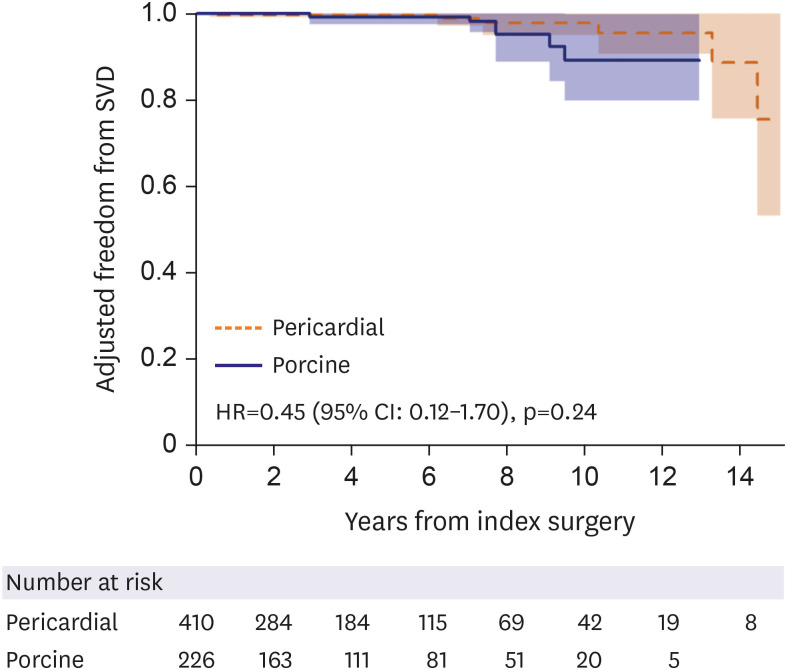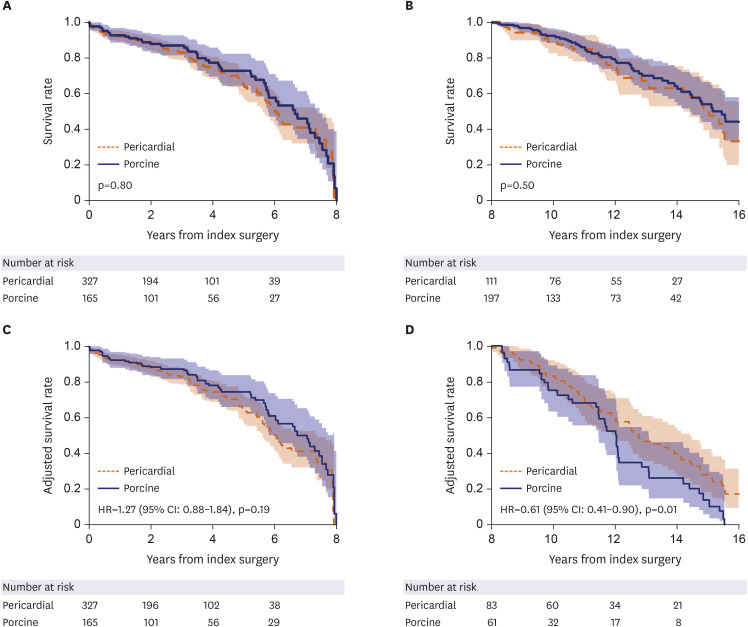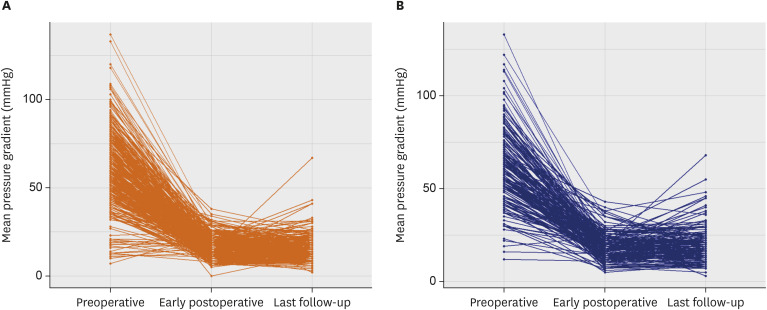Korean Circ J.
2022 Feb;52(2):136-146. 10.4070/kcj.2021.0223.
Pericardial Versus Porcine Valves for Surgical Aortic Valve Replacement
- Affiliations
-
- 1Department of Thoracic and Cardiovascular Surgery, Korea University Ansan Hospital, Korea University College of Medicine, Ansan, Korea
- 2Department of Thoracic and Cardiovascular Surgery, Yongin Severance Hospital, Yonsei University College of Medicine, Yongin, Korea
- 3Department of Thoracic and Cardiovascular Surgery, Asan Medical Center, University of Ulsan College of Medicine, Seoul, Korea
- KMID: 2525453
- DOI: http://doi.org/10.4070/kcj.2021.0223
Abstract
- Background and Objectives
There still are controversies on which type between bovine pericardial and porcine valves is superior in the setting of aortic valve replacement (AVR). This study aims to compare clinical outcomes of AVR using between pericardial or porcine valves.
Methods
The study involved consecutive 636 patients underwent isolated AVR using stented bioprosthetic valves between January 2000 and May 2016. Of these, pericardial and porcine valves were implanted in 410 (pericardial group) and 226 patients (porcine group), respectively. Clinical outcomes including survival, structural valve deterioration (SVD) and trans-valvular pressure gradient were compared between the groups. To adjust for potential selection bias, inverse probability treatment weighting (IPTW) was conducted.
Results
The mean follow-up duration was 60.1±50.2 months. There were no significant differences in the rates of early mortality (3.1% vs. 3.1%; p=0.81) and SVD (0.3%/patient-year [PY] vs. 0.5%/PY; p=0.33) between groups. After adjustment using IPTW, however, landmark mortality analyses showed a significantly lower late (>8 years) mortality risk in pericardial group over porcine group (hazard ratio [HR], 0.61; 95% confidence interval, [CI] 0.41–0.90; p=0.01) while the risks of SVD were not significantly difference between groups (HR, 0.45; 95% CI, 0.12–1.70; p=0.24). Mean pressure gradient across prosthetic AV was lower in the Pericardial group than the Porcine group at both immediate postoperative point and latest follow-up (p values <0.001).
Conclusions
In patients undergoing bioprosthetic surgical AVR, bovine pericardial valves showed superior results in terms of postoperative hemodynamic profiles and late survival rates over porcine valves.
Keyword
Figure
Cited by 1 articles
-
We Always Have a Choice: Pericardial Versus Porcine Valves for Surgical Aortic Valve Replacement
Hyun Keun Chee
Korean Circ J. 2022;52(2):147-149. doi: 10.4070/kcj.2021.0386.
Reference
-
1. Baumgartner H, Falk V, Bax JJ, et al. 2017 ESC/EACTS guidelines for the management of valvular heart disease. Eur Heart J. 2017; 38:2739–2791. PMID: 28886619.2. Glaser N, Jackson V, Holzmann MJ, Franco-Cereceda A, Sartipy U. Aortic valve replacement with mechanical vs. biological prostheses in patients aged 50-69 years. Eur Heart J. 2016; 37:2658–2667. PMID: 26559386.
Article3. Isaacs AJ, Shuhaiber J, Salemi A, Isom OW, Sedrakyan A. National trends in utilization and in-hospital outcomes of mechanical versus bioprosthetic aortic valve replacements. J Thorac Cardiovasc Surg. 2015; 149:1262–1269.e3. PMID: 25791947.
Article4. Du DT, Lu X, McKean S, et al. Selection of prosthetic aortic valves in the United States among elderly Medicare patients from 2006 to 2015. J Thorac Cardiovasc Surg. 2020; 159:62–69.
Article5. Chambers JB, Rajani R, Parkin D, et al. Bovine pericardial versus porcine stented replacement aortic valves: early results of a randomized comparison of the Perimount and the Mosaic valves. J Thorac Cardiovasc Surg. 2008; 136:1142–1148. PMID: 19026794.
Article6. Walther T, Lehmann S, Falk V, et al. Prospectively randomized evaluation of stented xenograft hemodynamic function in the aortic position. Circulation. 2004; 110:II74–II78. PMID: 15364842.
Article7. Dalmau MJ, González-Santos JM, López-Rodríguez J, Bueno M, Arribas A, Nieto F. One year hemodynamic performance of the Perimount Magna pericardial xenograft and the Medtronic Mosaic bioprosthesis in the aortic position: a prospective randomized study. Interact Cardiovasc Thorac Surg. 2007; 6:345–349. PMID: 17669862.
Article8. Borger MA, Nette AF, Maganti M, Feindel CM. Carpentier-Edwards Perimount Magna valve versus Medtronic Hancock II: a matched hemodynamic comparison. Ann Thorac Surg. 2007; 83:2054–2058. PMID: 17532395.
Article9. Hickey GL, Grant SW, Bridgewater B, et al. A comparison of outcomes between bovine pericardial and porcine valves in 38,040 patients in England and Wales over 10 years. Eur J Cardiothorac Surg. 2015; 47:1067–1074. PMID: 25189704.
Article10. Andreas M, Wallner S, Ruetzler K, et al. Comparable long-term results for porcine and pericardial prostheses after isolated aortic valve replacement. Eur J Cardiothorac Surg. 2015; 48:557–561. PMID: 25527170.
Article11. Ganapathi AM, Englum BR, Keenan JE, et al. Long-term survival after bovine pericardial versus porcine stented bioprosthetic aortic valve replacement: Does valve choice matter? Ann Thorac Surg. 2015; 100:550–559. PMID: 25986098.
Article12. Gao G, Wu Y, Grunkemeier GL, Furnary AP, Starr A. Durability of pericardial versus porcine aortic valves. J Am Coll Cardiol. 2004; 44:384–388. PMID: 15261935.
Article13. Akins CW, Miller DC, Turina MI, et al. Guidelines for reporting mortality and morbidity after cardiac valve interventions. J Thorac Cardiovasc Surg. 2008; 135:732–738. PMID: 18374749.
Article14. Song SO, Jung CH, Song YD, et al. Background and data configuration process of a nationwide population-based study using the Korean National Health Insurance system. Diabetes Metab J. 2014; 38:395–403. PMID: 25349827.
Article15. Therneau TM, Grambsch PM. Modeling Survival Data: Extending the Cox Model. New York (NY): Springer;2000.16. Johnston DR, Soltesz EG, Vakil N, et al. Long-term durability of bioprosthetic aortic valves: implications from 12,569 implants. Ann Thorac Surg. 2015; 99:1239–1247. PMID: 25662439.
Article17. Dalmau MJ, González-Santos JM, Blázquez JA, et al. Hemodynamic performance of the Medtronic Mosaic and Perimount Magna aortic bioprostheses: five-year results of a prospectively randomized study. Eur J Cardiothorac Surg. 2011; 39:844–852. PMID: 21193320.
Article
- Full Text Links
- Actions
-
Cited
- CITED
-
- Close
- Share
- Similar articles
-
- We Always Have a Choice: Pericardial Versus Porcine Valves for Surgical Aortic Valve Replacement
- Comparable Outcomes of Bicuspid Aortic Valves for RapidDeployment Aortic Valve Replacement
- Measurement of Porcine Aortic and Pulmonary Valve Geometry and Design for Implantable Tissue Valve
- Artificial Heart Valve Replacement
- Expanding transcatheter aortic valve replacement into uncharted indications





